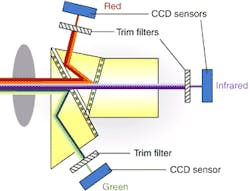Multispectral cameras render precise colors
Andrew Wilson, Editor, [email protected]
Accurate reproduction of colors in digital images for applications such as remote sensing, machine vision, and fluorescence imaging requires the use of multispectral imaging systems. Using cameras that sample light from objects through multiple spectral bands, these systems reproduce more accurate color images than when broadcast-standard color cameras are used.
"In fluorescence imaging, for example, an excitation wavelength is typically used to illuminate the target and cause the fluorescence," says David Duncan, director of engineering at DuncanTech (Auburn, CA). "Fluorescence caused by this excitation generally occurs at one or more wavelengths that are different from the excitation source. In capturing fluorescence images, a narrow-band filter at the fluorescence wavelength excludes excitation light," he adds. Using a multichannel camera, one channel can capture an image based on excitation illumination while the other two channels can be filtered for the fluorescence wavelengths.
Several methods exist to produce such multispectral cameras. One approach involves use of a single image sensor coupled to a filter wheel to obtain the required filtered wavelengths. Last year, Delta Danish Electronics, Light & Acoustics (Lyngby, Denmark; www.delta.dk), announced an Imaging Color Analyzer Module (ICAM) that uses such a filter-wheel configuration to obtain the tristimulus color values of the CIE standard observer (see Vision Systems Design, Nov. 2001, p. 10). With a resolution of 1024 X 768 X 8 bits, the camera is capable of capturing one color image in about two seconds.
For applications that demand even greater resolution and dynamic range, Integrated Scientific Imaging (ISI; Santa Barbara, CA) has developed the CCD800 and CCD1600 cameras. Designed for low-light imaging, including fluorescence, confocal, and electron microscopy, the cameras use KAF1602E and KAF0401 CCDs from Eastman Kodak (Rochester, NY) to attain resolutions of 1024 x 1536 and 512 x 768 pixels, respectively, and a dynamic range of 14 bits. With a built-in eight-position filter wheel that supports automated tricolor or multispectral imaging, both cameras can be controlled by a PC or laptop using an I/O interface card or a PCMCIA interface.
Because such filter-wheel designs use single image sensors to capture multispectral images, they are limited to applications where there is no motion of the object being imaged. To overcome this limitation, several companies, including DuncanTech and TVI Vision (Helsinki, Finland), have developed color cameras that use a color-separating prism to split the broadband light entering the camera through the lens into three optical channels. An optical trim filter and a CCD imaging array are then placed at each of the three exit planes of the prism.
Based on this technology, the DuncanTech MS4100 camera features three 1920 X 1080-pixel CCD imaging sensors, a rate of 5-10 frames/s, and a Camera Link interface. In addition to capturing RGB images, the camera can be configured with separate filters to acquire red, green, and near-infrared bands that approximate the Landsat satellite bands or CIE filters to directly image in CIE color space.
Multiple lenses, detectors, and filters are also being used in other multispectral camera designs. At Tetracam (Chatsworth, CA), for example, the company has developed a Multiple Camera Array (MCA) camera that consists of up to four sensor channels, each of which has a detector/bandpass filter/lens mounted in a common optical block. Built as C-mount cameras, the MCA allows interchangeable lenses and customer-designated passband filters. The camera system can be supplied with an embedded global-positioning-system (GPS) receiver that permits operation with GPS-triggering software to trap the current GPS data string with each image.
While each multispectral camera design offers distinct advantages, most camera vendors do offer custom designs to meet special needs. These may include developing distinctive filters and optics to meet a variety of passband requirements for custom-built camera systems. Despite this advantage, such cameras have yet to find favor in low-cost machine vision applications, where cost is of primary importance and absolute color measurement may not be a requirement.

